Chert Rock Type: Geological Characteristics and Uses
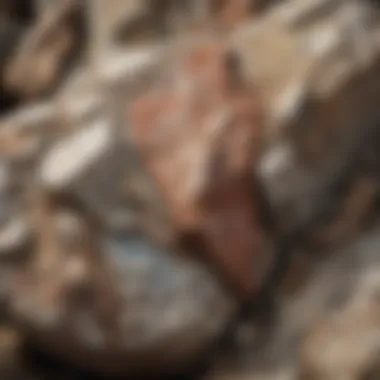
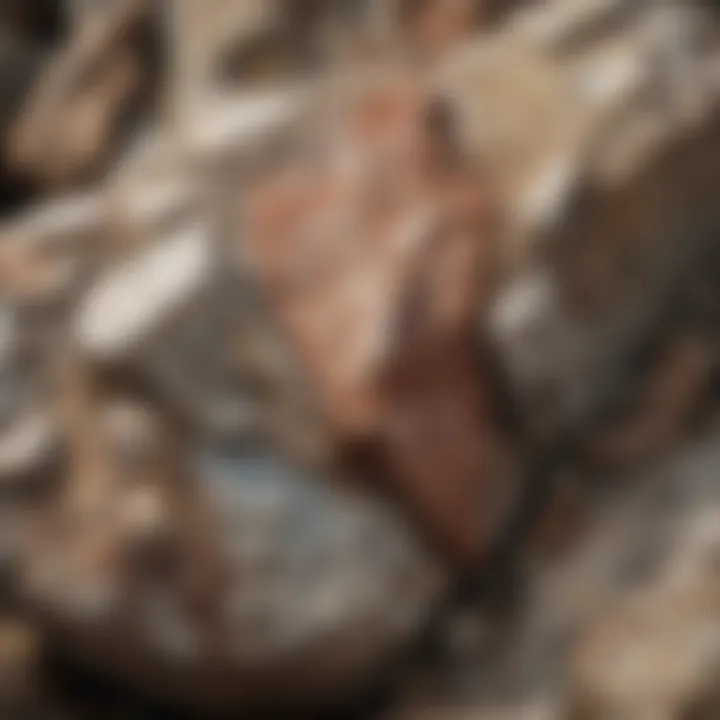
Intro
Chert rock is not just another sedimentary rock; it's a fascinating subject of exploration that captures the attention of both amateur collectors and experts. This unique material, largely made up of microcrystalline quartz, offers a rich tapestry of geological forms and historical significance. As we journey into the depths of chert, we'll uncover its various types, its formation process, and its significance across different eras and cultures.
Understanding chert opens the door to the worlds of geology, paleontology, and archaeology. The rock itself is known for its toughness and versatility, often appearing in a range of colors and formations. Far more than mere geological curiosities, chert varieties play crucial roles in various fields. This article intends to paint a full picture for enthusiasts eager to explore the intricacies of chert, from identification techniques to its uses through history.
As we delve into each section, expect to find valuable insights on how to identify this rock, its contribution to archaeological findings, and the theories surrounding its formation.
Featured Collectible of the Month
Overview
Chert can be a collector’s dream. With its striking appearances and varied textures, it makes for a standout addition to any collection. The different kinds of chert offer distinct characteristics that often reflect the environmental conditions in which they were formed. Whether it's the vibrant hues of agatized chert or the patterned beauty of banded chert, collectors often find joy in discovering these unique variations.
Historical Significance
Historically, chert has been a valuable resource, utilized by ancient cultures for tools and weapons due to its sharpness when fractured. Pebbles of chert have been found in archaeological sites, providing clues to early human life and technological advancements. Chert artifacts not only showcase the skills of ancient artisans but also tell a story about the resourcefulness of early societies and their understanding of their environment.
“The presence of chert in ancient artifacts often suggests a complex knowledge of geology by prehistoric peoples, showcasing how they adapted to their surroundings.”
Identification Techniques
Identifying chert might seem daunting, but it can be simplified through careful observation and practice. Collectors and enthusiasts can develop their skills using several key techniques.
Visual Characteristics
- Color: Chert displays a wide range of colors, including gray, brown, red, and even green, influenced by the presence of other minerals.
- Texture: The surface of chert can vary from smooth to rough. Examine its luster; it often has a waxy or glassy appearance.
- Breakage: Chert fractures conchoidally, showcasing smooth, curved surfaces, making it easy to identify.
Resources for Identification
To increase identification skills, several resources can be incredibly helpful:
- Books and Guides: There are numerous field guides that focus on rocks and minerals, specifically chert.
- Online Forums: Platforms like Reddit feature communities where collectors share their experiences and tips.
- Local Groups: Joining a rock and mineral club can provide hands-on experience and insights from seasoned collectors.
As we continue to explore chert within the following sections, it becomes increasingly clear that this rock type serves as a bridge connecting various fields of study and interest, offering a wealth of knowledge for the avid enthusiast.
Prelims to Chert
Chert is more than just another rock type; it stands as a silent witness to geological processes that span eons. In this section, we delve into the significance of chert in understanding the earth's history and the role it plays across various fields. From providing insights into paleoenvironments to shaping human culture, chert's importance cannot be understated.
Definition and Composition
Chert, fundamentally, is a sedimentary rock composed of microcrystalline quartz—essentially, tiny crystals of silicon dioxide. Its formation typically occurs in marine environments, where biogenic silica from organisms like diatoms and radiolarians accumulates and lithifies over time. The overall composition is often interspersed with various impurities, such as organic matter, iron oxides, and feldspar, leading to its diverse color palette. This rock can be smooth reflective or rough and dull, depending largely on its formation and mineral content.
Interesting to note, chert can be found in a spectrum of hues, ranging from the classic light gray to deep reds and even greens. This spectrum arises from the different minerals incorporated during the sedimentation process, providing collectors and researchers alike with clues about the rock's origins and environment of formation. A deeper understanding of these elements reveals not only the complexity of geological processes but also highlights chert's value in the study of past climates and ecosystems.
Historical Context
Historically, chert has played a significant role during human development. Early civilizations leveraged its properties to create tools and weapons, which were essential for survival. Being a hard, durable material, it can be flaked easily to produce sharp edges, making it ideal for crafting arrowheads and hand axes. Cultures around the globe, from Native American tribes to prehistoric Europeans, harnessed this rock, elevating it to a cornerstone of technology during the stone age.
"Chert is not just a geological specimen; it's a bridge connecting us to our ancestors and their survival strategies."
Archaeological findings often reveal chert tools at ancient sites, underlining its durability and widespread use. The material also features prominently in burial practices among various cultures. In some cases, it was even believed that chert contained spiritual properties, linking the material to rituals and mythology.
The study of chert doesn’t only stop at its use as tools but extends into a reflection of the human experience throughout history. As we explore the various characteristics and uses of chert in subsequent sections, it becomes clear that this rock type is instrumental in bridging our understanding of both geological and anthropological disciplines.
Geological Characteristics
Understanding the geological characteristics of chert is essential as it helps us to fully grasp the rock's origins and its implications in various fields. Chert's formation processes, physical properties, and its inherent qualities deeply inform us about its historical and modern uses. Each characteristic tells a story of environmental conditions, ancient biological processes, and the rock's geological journey through time.
Formation Processes
Chert forms primarily through the accumulation of silicon dioxide, often derived from the breakdown of organisms, particularly radiolarians and diatoms, which lived in ancient sea environments. This sedimentation creates a dense structure that can withstand considerable geological forces. The transformation from sediment to rock can happen over millions of years, driving home the importance of understanding the environmental conditions of the time. By studying these processes, geologists can infer past climatic conditions and oceanic settings that contributed to the rock's formation.
Chert can also form in precipitation processes when silica-rich fluids percolate through pores in sedimentary rocks. This gives rise to various forms, including nodular or massive chert, reflecting different depositional environments.
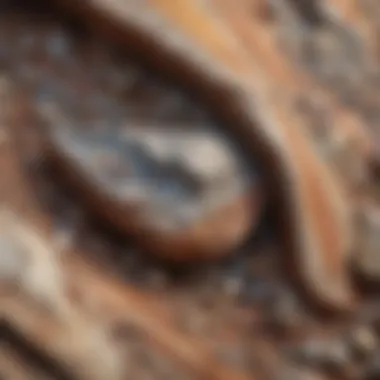
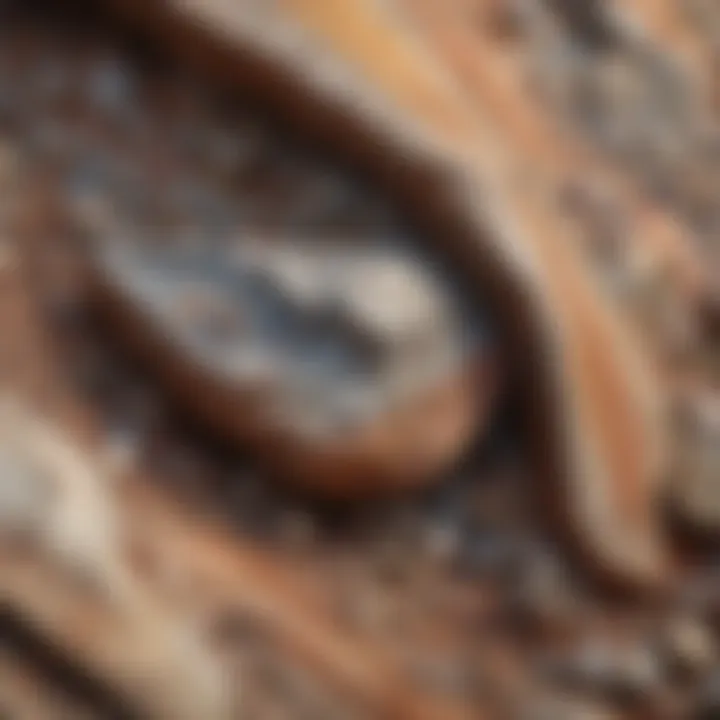
Physical Properties
Hardness and Durability
Chert is known for its remarkable hardness, ranking around 7 on the Mohs scale. This hardness is significant as it grants chert exceptional resilience against weathering and erosion, making it a long-lasting material in natural settings. Its durability is one key characteristic that makes it a formidable material in tool-making, from prehistoric times to modern applications.
The unique feature of chert's toughness facilitates its use in various high-impact environments. Archaeologists find tools made from chert often survived longer than those created from softer stones, which aids in understanding ancient lifestyles. However, one disadvantage is that the very hardness that makes it durable can also make it challenging to work with, sometimes resulting in the production of sharp, hazardous flakes during the knapping process.
Color Variation
Chert exhibits remarkable color variation, with hues ranging from light gray to deep black, and often showcasing dazzling patterns stemming from its mineral content. This variation is a reflection of its formation processes and the materials involved. The diverse colors not only enhance its aesthetic appeal, making it a sought-after material for collectors but also provides insights into its geological history.
The key characteristic of this color spectrum is its ability to indicate different depositional environments and the chemical processes at play during formation. For collectors, color variation can also influence the perceived value of certain specimens, impacting the market dynamics. Yet, it's vital to note that while color adds beauty and interest, it can also obscure identification for those less familiar with the specimen's geological history.
Luster and Texture
Luster and texture play significant roles in the identification of chert and contribute to its attractiveness as a specimen. Chert typically exhibits a waxy to glassy luster, providing it with an appealing sheen that can catch the eye of any collector. Its texture tends to be smooth and can vary from microcrystalline to more coarse forms, reflecting its unique formation process.
This variability allows for a broad range of chert specimens, each with distinct characteristics that appeal to enthusiasts. The smooth texture not only adds to its visual allure but also increases its desirability for tool-making since it allows for easier shaping and handling. However, the smoothness can also lead to difficulties in assessing certain types, especially when it comes to distinguishing between similar-looking varieties.
In sum, grasping the geological characteristics of chert gives us essential context to appreciate its role in both historical and contemporary use. It enhances our understanding of the past, guiding us as we explore the importance of this remarkable stone.
Varieties of Chert
Chert comes in a variety of forms, each reflecting its unique geological processes and environments of formation. Understanding these distinct varieties is crucial for rock and fossil collectors alike, as the differences can convey significant information about the geological history of an area, potential uses in various applications, and aesthetic appeal. Knowing the characteristics of each type can enhance one's ability to identify, collect, or utilize chert, making this section essential for anyone interested in the field.
Typical Forms
The most common types of chert present in geological formations include nodular chert, bedded chert, and microcrystalline chert.
- Nodular Chert: This form comprises irregularly shaped nodules embedded within sedimentary rocks. These can often be found in limestones or marls, indicating a diagenetic process where silica replaces carbonate materials over time.
- Bedded Chert: Often occurring as distinct layers, bedded chert signifies periods of sediment deposition in an environment rich in silica, such as oceanic conditions. These layers can vary greatly in thickness and composition.
- Microcrystalline Chert: This type appears very dense with a gloss finish, often resembling flint. Microcrystalline chert is known for its toughness, making it suitable for tools and industrial applications.
Collectors often seek out these different forms due to their unique aesthetic and historical significance. Each form tells a story about its environment and geological past, revealing details that may not be immediately apparent to the untrained eye.
Banded and Limestoned Chert
Banded chert, as its name implies, features characteristic bands of color that create striking visual patterns. These bands can result from variations in the deposit conditions, often influenced by the presence of organic material or differing mineral content. When examining banded chert specimens, one might observe hues ranging from deep reds to muted browns, produced through the interplay of iron oxide and silica during the formation process.
Conversely, limestoned chert is a hybrid of limestone and chert, typically found in marine environments where high levels of biogenic silica are present. The carbonate rock acts as a matrix, giving it a distinct texture and appearance. This type is particularly interesting to collectors because it not only reveals the silica's origin but also showcases fossils from the original limestone, offering a window into the prehistoric ecosystems that once thrived there.
Banded chert and limestoned chert exemplify how environmental conditions shape the character of geological materials.
Flint and Its Variants
Flint stands out as one of the most well-known forms of chert, famously utilized throughout history for tool-making. Varieties of flint include black flint, which is prized for its sharpness and ease of knapping, and white flint, which is commonly associated with caves and archaeological sites. Each type has unique qualities, but they share a common feature: their ability to break with a conchoidal fracture, which allows for the creation of thin, sharp edges needed for tools.
Additionally, one should note that regional varieties like 'English flint' or 'Chesapeake flint' can differ in texture and color, influenced by local geological factors. Such distinctions enrich the narrative of its use among ancient cultures and its applications in modern industries, including construction and art.
In summary, recognizing the various types of chert—whether typical forms or more specialized varieties like banded chert and flint—allows collectors and enthusiasts to appreciate the complexity and beauty inherent in these geological materials. The distinctions guide collectors not just in identification but also in understanding the broader geological stories etched into these ancient rocks.
Identification Techniques
Identifying chert is critical for anyone interested in its geological and archaeological contexts. Techniques used for identifying chert help in distinguishing it from similar materials, thus enhancing our understanding of its properties and uses. For enthusiasts and collectors alike, knowing how to identify chert accurately opens doors to its historical applications and cultural symbolism.
Visual Inspection
Visual inspection is often the first step in identifying chert. By closely examining its color and texture, collectors and geologists can make initial assessments that inform further analyses.
Assessing Color and Texture
The color of chert can range widely, from shades of grey to deep reds, and this variety often reflects its mineral content and formation history. For example, a red hue typically indicates iron oxide presence. Texture plays a crucial role, as well; chert can be smooth or remarkably rough, and its microcrystalline structure may display a glossy sheen.
This characteristic is beneficial because it allows quick identification in the field. Understanding the color and texture provides insights into the rock's environment of deposition and can often suggest locations where the chert might be plentiful. The advantage of visual inspection lies in its accessibility; it doesn't require special equipment, meaning that both experts and amateurs can apply it effectively. However, one drawback is that this method can lead to misinterpretation, particularly for novices who might confuse chert with other rocks such as jasper or agate.
Identifying Fossils Within Chert
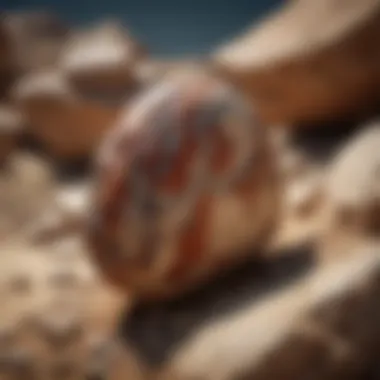
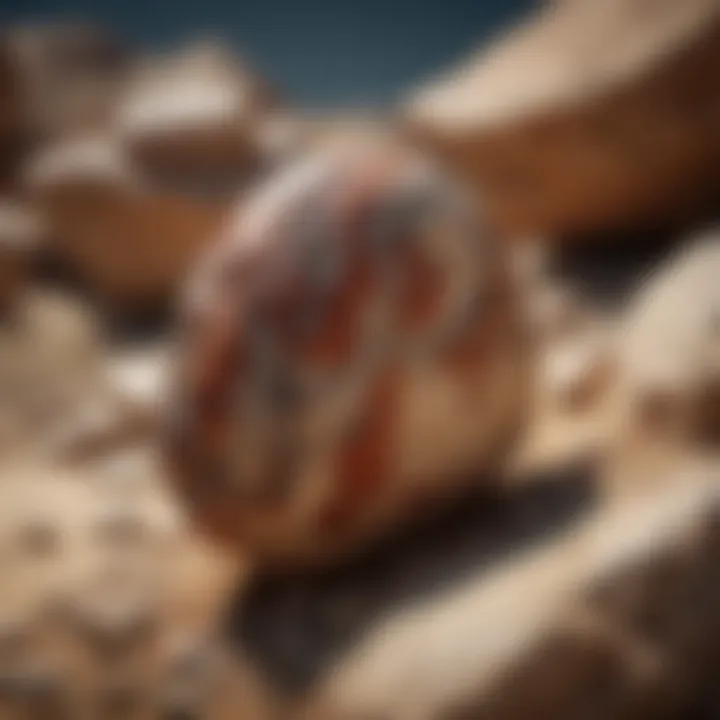
Chert is known for its capacity to encapsulate fossils. Identifying these fossils within chert can be a pivotal indicator of the rock's age and the environment of deposition. Fossilization processes often leave telltale signs, such as impressions or crystal formations. The presence of fossils not only adds scientific value but also enhances the aesthetic appeal of the specimen.
This technique is popular in both geological studies and for collectors because it enriches the narrative attached to the rock. Understanding the fossils within can also aid in the identification of the specific type of chert. The unique feature of fossil-bearing chert is that it serves as a biological record, bridging prehistoric life with geological history. A potential disadvantage is that not all chert specimens contain fossils, and those lacking this aspect may become more challenging to date accurately.
Field Testing Methods
Following visual inspection, field testing methods come into play. These techniques provide a more hands-on approach to identifying chert and can involve simple tests that anyone can apply during their explorations. Techniques may include scratching the surface to check hardness or using a hammer to assess sound when struck. Besides tactile examination, observing the rock under natural light can reveal additional details about its formation, helping collectors distinguish chert from similar-looking rocks. Thus, combining visual inspection with field testing enhances the identification process and enriches overall knowledge about this fascinating rock type.
Uses of Chert
Chert's versatility has marked its importance across various fields throughout history. Its unique characteristics, such as its hardness and ability to be fractured with a sharp edge, have led to its utilization in numerous practical applications. Understanding how chert has been used not only sheds light on its geological significance but also contributes to the appreciation of its role in human culture and industry. The exploration of chert's uses can be categorized into historical and modern applications, both of which highlight how this unassuming rock has shaped various facets of life.
Historical Applications
Tools and Weapons in Prehistory
The use of chert in making tools and weapons during prehistoric times stands testament to human ingenuity in adapting to their environment. Early humans recognized chert's sharp edges, which could be produced by flaking the rock, making it an exceptional material for crafting cutting tools and projectile points. Commonly found in archaeological sites, chert tools have offered insight into ancient lifestyles, which were often heavily reliant on hunting and gathering.
Key characteristics of chert that made it a beneficial choice include its availability in many regions and its superior sharpness compared to softer stones.
The unique feature of chert tools is their ability to hold an edge longer than that of many other materials, offering greater efficiency for tasks such as butchering game or woodworking. However, while chert was advantageous, it could also be somewhat brittle, posing a risk of breakage during heavy use. The fact that ancient peoples chose it for crucial survival tools emphasizes chert’s significance in their development.
Artistic Uses
In addition to its practical applications, chert has served artistic purposes throughout history. Various cultures have used chert to produce intricate carvings and decorative items. The smooth finish and often vibrant colors of certain chert varieties make it a desirable material for artists and artisans aiming to create aesthetic objects.
A key aspect of artistic uses is its workability; artists could shape the stone relatively easily, allowing for detailed designs that could express cultural narratives or spiritual beliefs. A unique feature of these artistic items is their multifunctionality—they often served as both tools and symbols of status or spirituality.
However, the challenge with artistic uses is the availability of high-quality chert. Not all chert is created equal, and some may lack the color or clarity needed for artistic expression. Nonetheless, for those fortunate enough to source quality chert, the advantages in terms of creative potential cannot be understated.
Modern Industrial Uses
In today’s industrial landscape, chert finds applications in a variety of sectors. Its durability and abundance make it an ideal choice for materials used in construction. For instance, crushed chert is often utilized as an aggregate in concrete and asphalt, providing strength and enhancing the structural integrity of numerous projects.
Furthermore, chert's unique properties have sparked interest in its use for road construction and maintenance. Due to its resistance to weathering, it serves well as a decorative stone in landscaping and as a substitute for gravel.
The modern approach has led to the value of chert being recognized not just as a natural resource but as a sustainable one. The ease of sourcing it, coupled with its durability, means that utilizing chert in industry could provide economic benefits alongside environmental sustainability.
"Chert has transitioned from a primitive tool material to a valuable resource in modern engineering, showcasing its versatility across the ages."
Overall, as we appreciate the diverse uses of chert from past to present, we find both continuity and evolution in its role, symbolizing humanity's ongoing relationship with this remarkable rock.
Chert in Paleontology
Chert plays a pivotal role in paleontology, serving as a protective vessel for fossils and revealing key insights into past ecological systems. This fascinating rock type not only encapsulates remnants of ancient life but also provides a window into the evolutionary pathways that have shaped our planet. Through careful study, paleontologists can decode the stories etched into chert, enhancing our understanding of prehistoric environments and the organisms that inhabited them.
Fossilization Processes
The processes that lead to the fossilization of organisms within chert are quite intriguing. Generally, these processes can be categorized into the following stages:
- Initial Burial: When an organism dies, rapid burial in sediment is crucial for preventing decay. In the case of chert, sediments rich in silica are often involved.
- Silicification: Over time, silica-rich solutions permeate the sediments. This process leads to the replacement of organic material with silica, preserving the fine details of the fossil.
- Diagenesis: This refers to the physical and chemical changes that occur in sediments over time. With chert, these changes often enhance the preservation quality of fossils, making them more detailed for future study.
This process enables unique fossil forms—like those of sponges or delicate corals—to be immortalized within chert, allowing modern scientists a clear view of life forms from times long gone.
"In many cases, chert can serve as a fossil time capsule, providing invaluable insight into the biodiversity and ecological dynamics of ancient oceans."
Significance in Geological Studies
Chert's significance extends well beyond its role in fossilization. It becomes a critical element in geological studies for several reasons:
- Stratigraphic Correlation: Chert can help in understanding stratigraphic sequences and the development of ancient rock layers. This correlation is essential for reconstructing historical geographies.
- Paleoenvironmental Indicators: The characteristics of chert can indicate past environments. For example, the presence of certain fossils within chert layers might suggest that these sediments were deposited in a shallow marine environment, while others can indicate deep-sea conditions.
- Geochemical Proxies: Chert can store and preserve geochemical signatures that reveal climatic conditions during the time of formation. These signatures can reveal temperature trends, nutrient availability, and even ocean circulation patterns.
In summary, chert is not just a rock; it's a precious artifact of geological history, providing researchers with clues about the Earth's past environments and the life forms that thrived within them. Understanding these layers is invaluable for comprehending the timeline of life and the environmental changes that punctualized it.
Cultural Significance
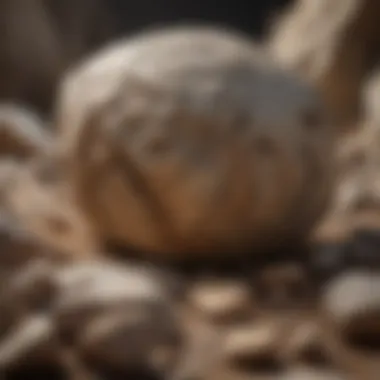
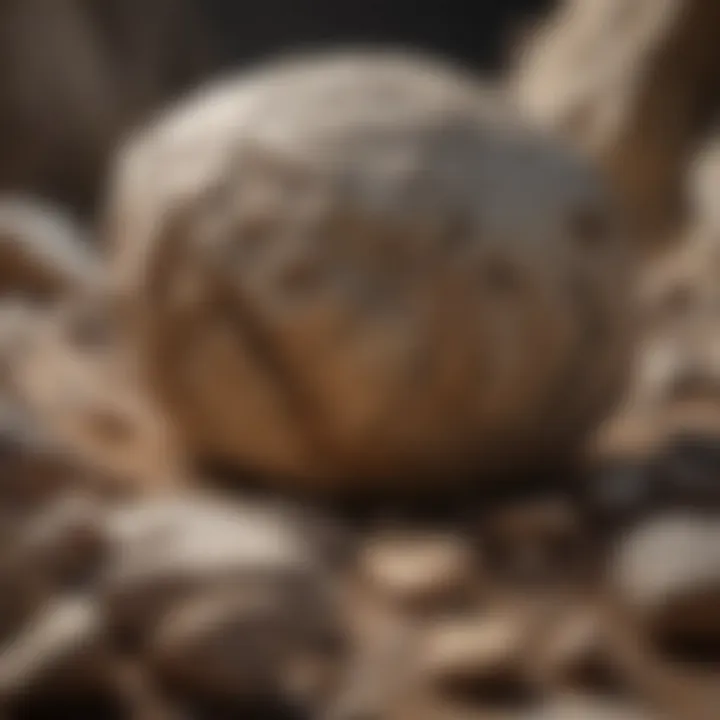
The cultural significance of chert extends far beyond its physical characteristics and geological properties. This rock type, imbued with historical relevance, also carries symbolic associations in various ancient cultures. Archaeological finds indicate that chert has been integral in the daily lives of many civilizations, often intertwined with their beliefs, practices, and artistic expressions.
Symbolism in Ancient Cultures
Chert's role as a tool and resource positioned it at the heart of many ancient cultures. For example, its sharp edges made it an ideal material for crafting tools like knives and arrowheads. These instruments were not just functional; they held deeper meanings. For many indigenous tribes, such as the Native Americans, tools made from chert were often seen as gifts from the earth, serving as a bridge between the physical and spiritual realms.
- Creation Myths: In some cultures, chert was associated with creation myths. It was believed that the first people or ancestors shaped from or adorned with chert would grant strength and resilience.
- Burial Practices: Chert artifacts have been discovered in burial sites, suggesting that they played a vital role in rituals of the afterlife. Such artifacts were frequently placed with the deceased, believed to assist them on their journey.
These examples illustrate that chert was not merely a utilitarian material; it enriched the cultural tapestry of societies, acting as both a tool and a sacred object.
Chert in Rituals and Mythology
Chert's impact is undeniable in the context of rituals and mythology. Many societies have utilized chert in ceremonies, imbuing it with a sense of mystique that elevated its status. The rock type often found itself woven into the very fabric of mythological stories.
- Ritual Tools: In certain rites, chert tools were used, believed to channel spiritual energies. For instance, the shape and sharpness of a chert blade could represent a connection to the divine or to ancestral spirits.
- Symbol of Strength: Traditionally, different colors and patterns in chert carried specific meanings. Red chert, for instance, might symbolize vitality and life, while black chert could represent protection.
"The significance of chert resonates through the ages, linking us to those who came before and allowing a deeper understanding of their lives and beliefs."
This reflects the layered significance of chert beyond mere material worth—its varied uses in rituals emphasize the necessity of cultural context in appreciating its value.
As we explore chert, it is critical to understand that its cultural significance is an integral part of its narrative, revealing both a connection to the earth and an echo of human experience, shaping how communities celebrated, mourned, and remembered.
Collecting and Preservation
Collecting chert can be an engrossing endeavor, morphing from a casual hobby into a serious passion for many enthusiasts. The process of collecting involves hunting for unique specimens, understanding their characteristics, and ensuring their preservation for future appreciation. This section discusses best practices that every collector should bear in mind, alongside community resources that enhance the overall experience of collecting chert.
Best Practices for Collectors
Identifying Authentic Chert
Identifying authentic chert is crucial for both seasoned collectors and newcomers alike. Authentic chert often possesses specific characteristics that set it apart from imitations. The most notable trait of chert is its fine-grained texture that feels almost glassy to the touch. Unlike other rocks, authentic chert fractures in a conchoidal manner, creating sharp edges. This characteristic is not just a marker of authenticity, but it also highlights its historical significance, as ancient peoples relied on this feature for tool-making.
One of the unique features of authentic chert is its ability to hold a keen edge, making it a popular choice for primitive technology enthusiasts. Understanding these properties can aid collectors in avoiding less valuable imitations. Additionally, many seasoned collectors recommend conducting a simple scratch test on the rock's surface. If it marks easily, it might not be true chert.
Care and Maintenance
Proper care and maintenance extend the life of collected specimens significantly. This involves minimizing exposure to harsh sunlight and avoiding extreme temperature fluctuations, both of which can cause fractures. Cleaning should be done with care, using soft brushes and gentle soap to remove dirt without damaging the patina.
Collectors should remember that chert is relatively durable but still susceptible to scratches. A key characteristic of care and maintenance is understanding how to store your collection. Keeping pieces in breathable felt pouches or cushioned containers can prevent unintentional damage.
Importantly, maintenance isn't purely about the physical condition of the specimens; it’s about documenting where and how each piece was acquired. This provenance adds value not only in historical research but also in potential resale situations.
Community and Resources
Engaging with a community of fellow collectors can provide invaluable insight into best practices and resources. Online platforms, such as forums on Reddit or Facebook groups dedicated to geology enthusiasts, serve as great starting points. These communities often share their experiences, identify authentic specimens, or discuss care tips that new collectors may overlook.
Moreover, local rock hounding clubs can offer organized outings where you can not only find chert but also connect with seasoned collectors. Many clubs provide workshops focused on identification techniques, preservation methods, and even tools of the trade.
In summary, collecting chert requires an understanding of authenticity, rigorous care, and a collaborative spirit within the community. By adhering to these best practices and utilizing available resources, collectors can enhance their experience and develop both knowledge and appreciation for this intriguing rock type.
The End
In wrapping up our exploration of chert, it’s crucial to underscore the multifaceted importance this rock holds in various domains. Chert is not just another sedimentary rock; it’s steeped in a rich history that connects us to our ancestors and their crafting practices. The significance of its geological properties and its applications permeate both academic research and practical uses.
Recap of Key Insights
Let’s recapitulate the major takeaways from our investigation. Chert is primarily composed of microcrystalline quartz which gives it distinct physical properties. Its hardness and durability make it suitable for tool-making, a trait valued by ancient humans. Moreover, the varying colors and textures of chert allow for a plethora of artistic expressions and functional applications in modern manufacturing.
- Geological Characteristics: Chert forms through both biological and physical processes. Understanding these processes illuminates its diverse appearances and functionalities.
- Varieties of Chert: From banded types to less common variants like flint, each form of chert has unique features worth recognizing.
- Identification Techniques: Skills in visual inspection and practical tests are key for collectors looking to discern true chert from imitations. Identifying fossils embedded in chert can also dramatically enhance its value for a collector.
- Uses in History and Today: Historically, chert was a cornerstone for tool and weapon production. Today, it finds numerous applications in construction and industrial tools, solidifying its ongoing relevance.
Overall, these points highlight chert's role as both a historical artifact and a modern material, offering insights valuable to collectors and scholars alike.
Future Directions in Chert Research
Looking ahead, the field of chert research is ripe with potential. Experts are increasingly using advanced techniques like geochemical analysis to glean more information about the environmental conditions during its formation. This could broaden our understanding of prehistoric human behavior and migration patterns.
- Technological Advances: New imaging technologies might allow for finer examinations of chert’s properties. Such advancements could lead to enhanced interpretations about its manufacturing processes.
- Environmental Impact Studies: Research could focus on how chert deposits form in different geological settings, revealing much about Earth's history.
- Cultural Studies: Further examining the cultural contexts of chert use within ancient populations could provide deeper insights into their daily lives and beliefs.
By fostering interdisciplinary collaborations combining geology, archaeology, and anthropology, future research can help unravel the complex story of chert, revealing layers of meaning that have thus far remained hidden.
In essence, chert serves not only as a fascinating geological specimen but also as a bridge to past human experiences and future scientific inquiry.



